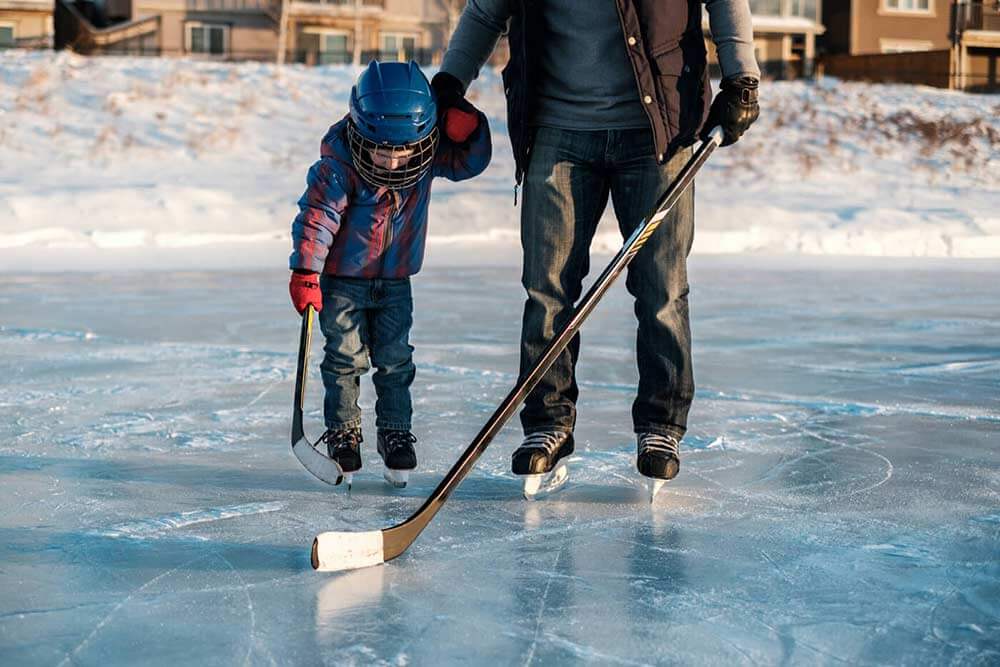How to build a backyard rink
Before you grab the hose and get started, you’ll want to do a little research around any bylaws in your city when it comes to backyard rinks or what can be done on your property. Depending on how you’re building your rink, your municipality may even require you to get a permit.
You’ll also want to create an overall game plan. Here are a few questions you should ask yourself:
1. Where in my yard will the rink go? You want to make sure there is easy access to your rink, while not blocking any entranceways to and from your house.
2. How big will the rink be? The size of your yard may make this decision for you. But, the larger you make your rink, the more time and water it will take to build and maintain it.
3. Is my yard flat? Or, is there a slope and in what direction? Ideally, you want to place your rink in a level location. If your backyard slopes, you’ll need to consider how to counteract this.
4. Does my backyard get a lot of sun? Too much sun on your rink may cause the surface to melt during the day, leaving a layer of water (or puddles) on top of your rink. Although this isn’t a deal breaker, it may make it a little harder to shoot a puck around. If you have the option to put your rink in a shadier spot, this is the better way to go.
5. How will I build my rink? Do I need a rink liner or kit? There are a lot of different options and techniques out there. When deciding which route to take, think about your time, skill level and reason for the rink. For example, you may just want to use a rink-in-a-bag if you’re looking at a smaller rink for recreational skating. If you’re looking to play hockey on the other hand, you may need to build a frame with boards and a liner. Do some research to find out what will work best for you.
6. What water source will I use? You’ll need to plan out your water source for filling and flooding, since outdoor pipes may be frozen or drained for the winter. You’ll likely need to find a way to route your hose outside from an indoor location, such as from your laundry sink’s faucet.
7. Is the rink in a spot that is well-lit if used at night? This will help keep everyone safe and having a good time. If you don’t already have outdoor lights for your backyard, you may want to think about hanging up a flood light for ultimate visibility. If you need to use an extension cord, make sure that it’s rated for outdoor use and take it back inside once you’re done skating for the day.
8. When is it cold enough to start the rink? Temperature plays a big part in creating the perfect rink. Although you can build your rink form ahead of time, you’ll need to wait until the temperature is consistently below freezing (think at least -5°C) to start filling or flooding it with water. This will ensure your rink is frozen solid.
How to maintain a backyard rink
Since you probably don’t have a Zamboni just lying around, you’ll need to think about how you’ll keep the ice surface smooth and ready to skate. Typically, the rink will need a flood after every skate, with the best time for a flood being in the morning or at night (when the sun isn’t shining directly on your rink). Be sure to closely watch the weather in your area to know when it’s cold enough, but not too cold, for a flood.
Don’t forget to consider that this will be an extra area that will require shoveling after a snow fall (as well as after each skate). And, if there are trees nearby, you’ll need to be on leaf alert to make sure they don’t end up causing divots in your ice surface.
How to use a backyard rink
This is why all the hard work is worth it. Enjoying a skate or game of shinny with your friends and family is what backyard rinks are all about. That being said, if there will be a lot of hockey played out on your rink, you may want to consider putting up boards or nets to help prevent fly away pucks.
It’s important to remember that building a backyard rink on your property does create a liability risk. What if someone gets hurt, or what if your child shoots a hockey puck through your neighbour’s window (or what if you do accidentally)? This is actually where the
It’s best practice to create rules for the rink to help keep everyone safe and having fun. For example, you might want to ask everyone to wear a helmet whenever they are on the ice or only allow the kids to use the rink when supervised.
How to take down a backyard rink
This is actually best to think about back at the start. Building your rink too close to your house could create the potential for flooding in the spring when the ice melts. Alternatively, you don’t want all this water running into your neighbour’s lawn or house if your backyard slopes towards them. It’s all about location, location, location.
You’ll also want to consider how you will store any parts of your rink during the off season so that they are in tip-top shape for use again next year.
